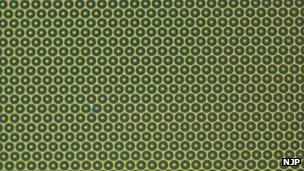'Cloaking' idea traps a rainbow
- Published

The work has been described as "encouraging and exciting"
Researchers have trapped a rainbow - slowing light to a near-stop - in an array of 25,000 "invisibility cloaks", each smaller than a hair's breadth.
A <link> <caption>report in the New Journal of Physics</caption> <url href="http://iopscience.iop.org/1367-2630/14/5/053029/" platform="highweb"/> </link> shows how the quest for an invisibility cloak is leading to cleverer ways to use and manipulate light.
The trick could aid the analysis of complex samples or even communications.
In recent years, a number of research efforts has demonstrated a wide range of cloaking techniques.
Light can either be guided around or cancelled by a material that makes an object invisible to an observer.
For the most part, such cloaks have been tiny or limited in the range of colours or angles of light they work with.
Nevertheless, this kind of engineering of light and the paths it takes has in principle a great many applications besides invisibility.
Intensive interaction
Recently, researchers <link> <caption>writing in Physical Review B</caption> <url href="http://prb.aps.org/abstract/PRB/v84/i23/e235105" platform="highweb"/> </link> suggested that arranging a number of tiny cloaks in a two-dimensional grid could be put to use in biomedicine and sensing, as well as traditional camouflage.
Now, Vera Smolyaninova at Towson University in Maryland, US, and her colleagues have taken those ideas and put them into practice.
The team started with a commercially available "micro-lens array" - a grid of tiny lenses just 50 millionths of a metre across.
They coated the array with a thin film of gold and placed it above a flat, gold-coated sheet of glass.
Light shone in from the side, between the two, was guided around each tiny lens, creating a small cloaked region in the centre of each one.

Arrays of the cloaks could be used as a range of sensors
The effect of having the array of the lenses was to effectively slow the light down.
Just as in a prism, the effect was slightly different for light of different colours - so that light put in at one side would be spread out into its constituent colours across the surface.
This "trapped rainbow" effect was first predicted in 2007 <link> <caption>in a paper in Nature by Ortwin Hess and colleagues</caption> <url href="http://www.nature.com/nature/journal/v450/n7168/abs/nature06285.html" platform="highweb"/> </link> .
Analysis techniques that use many colours of light abound, from explosive detection to blood analysis - but the sensitivity of many methods depends on how much light interacts with the material being investigated.
Because slowed light can be made to interact much more intensively with matter, the trapped rainbow has always looked to be a useful way to improve those techniques.
Prof Hess, now at Imperial College London, called the work "encouraging and exciting".
"When coming up with that general concept of the trapped rainbow, it seemed to be a very fundamental effect and have wide application," he told BBC News.
"So taking this forward to the experimental stage is a very nice thing to see."
- Published26 January 2012
- Published27 March 2012
- Published1 February 2011
- Published26 September 2011
- Published24 June 2011